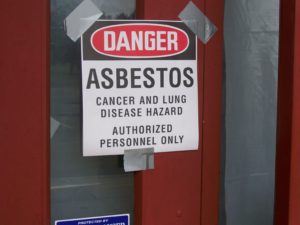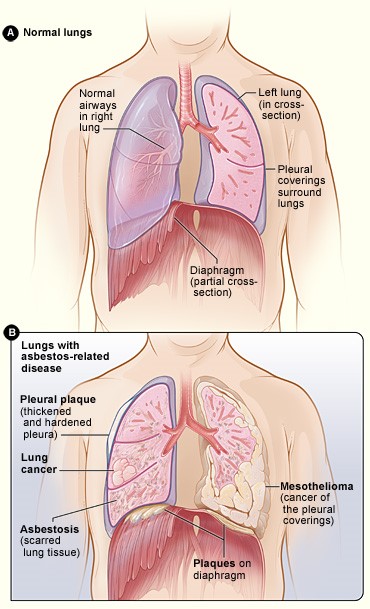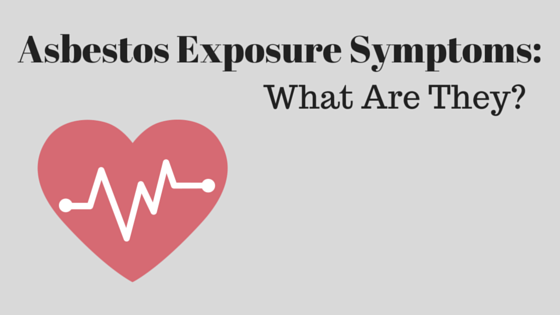While asbestos was once widely used throughout the United States for a number of products and projects, its use since the 1970’s has steadily declined. Despite this drop in use, asbestos is still utilized in some construction materials and there are still many homes with asbestos-containing products such as insulation. Now, after years of being around the material, people are coming forward with asbestos exposure symptoms.
These products and older buildings still present a health concern, so naturally you should be aware of how asbestos can affect you and what the symptoms of asbestos exposure are.
The concern with these lingering asbestos-containing products is that if they were disturbed—if they were sanded, cut, demolished, or drilled into they would release asbestos into the air.
If you’re wondering how much asbestos exposure is dangerous, it’s a matter of exposure over time as it accumulates in your lungs. This is why asbestos exposure has only recently become a health issue: people have had to accumulate significant quantities of it over time to begin exhibiting signs of exposure.
How asbestos exposure affects us

Because asbestos contains thin, microscopic fibers, exposure primarily leads to respiratory issues and problems with the lungs. When products containing asbestos are disturbed, the fibers are released into the air and can be breathed in. It’s the long-term accumulation of these fibers that leads to health issues, including:
- Asbestosis, an inflammatory condition of the lungs, causes shortness of breath and eventual scarring of the lungs
- Mesothelioma, a rare cancer that affects the lining of the lungs, chest cavity, and abdomen
- Lung cancer
- Pleural plagues
- Thickening of the lungs’ surrounding membranes
- Pleural effusions
The straight and sharp shape of asbestos fibers make it hard for the body to expel it and over time these fibers irritate the lungs and cause inflammation and scarring.
An explanation of symptoms caused by fibrosis
Fibrosis is the term for lung scarring, which causes symptoms ranging from shortness of breath to coughing, both commonly associated with conditions like asbestosis. This scarring causes long-term damage to the lungs that results in reduced functionality and fatigue. Advanced asbestosis can even lead to lung or heart failure.
Fluid buildup (pleural effusion) and thickening of the lining of the lungs (pleural thickening) are two other common symptoms that can be caused by fibrosis. An effusion can be caused by many things, such as lupus, pneumonia, and congestive heart failure, but also from inflammation of the lungs. Both pleural thickening and effusion constrict the lungs’ movements and the heart. This makes it difficult for either organ to expand, causing shortness of breath and fluid buildup.
The aforementioned fluid buildup can result in bloating, tenderness, swelling, and higher blood pressure. These symptoms may result in a loss of appetite and weight loss. Other symptoms that may accompany fibrosis include:
- Chest pain
- Chest tightness
- A dry, crackling sound in lungs during inhale
Over time, these symptoms may worsen or dissipate depending on the severity of your exposure and the length of time asbestos fibers have been accumulating in your lungs.
Lung cancer and advanced stages of asbestosis caused by exposure to asbestos

Prolonged exposure to asbestos could lead to forms of cancer, including lung cancer and mesothelioma. Those suffering from lung cancer may experience…
- Coughing, sometimes with blood
- Unexplained weight loss
- Difficulty breathing, shortness of breath, and wheezing
- Anemia
- Hoarseness
Mesothelioma of the lungs is accompanied by, predominantly, a shortness of breath and chest pain. However, abdominal mesothelioma features symptoms that range from weight loss and swelling/pain in the abdomen, to blood clotting abnormalities, bowel obstruction, anemia, and fever.
The important thing to remember here is that these symptoms are not exclusive to cancer or lung damage caused by asbestos-containing products. If you do experience any of these symptoms, it’s essential to talk to your primary care physician about what they could mean.
Obviously if you know that you work around asbestos or know that something in our home contains it, that information may help your doctor with diagnosing and understanding the cause of your problems, or recognize the signs of asbestos exposure symptoms.
